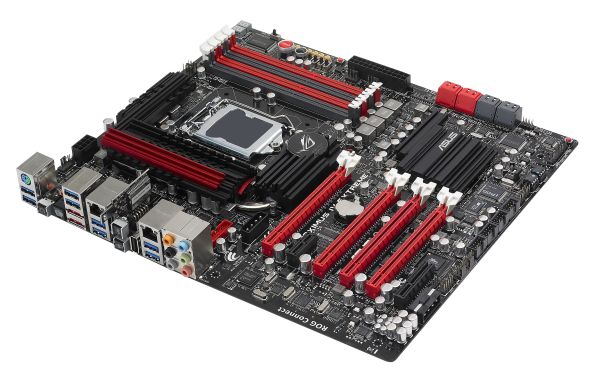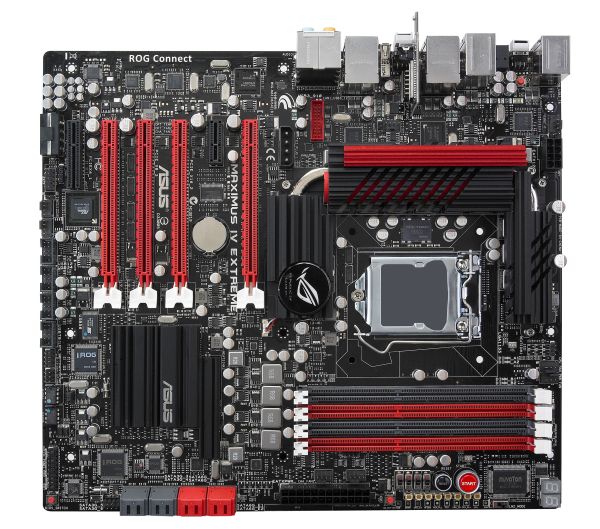A brief look at upcoming ASUS P67 Motherboards
by Ian Cutress on November 14, 2010 1:22 PM EST- Posted in
- News
- Motherboards
- Asus
The first board in the Sandy Bridge series with the Republic of Gamers moniker is the Maximus IV Extreme. This motherboard looks jam-packed with features, and we’d expect nothing less from a ROG product.
The red and black aside, ASUS are attempting to pushing the boat out for overclockers. Of immediate notice is beside the dual-channel DDR3 slots – alongside the power and reset buttons are a set of four switches, designed to enable and disable the PCIe slots as required. Beside these are a set of eight voltage readout points, allowing the monitoring of the various DRAM, NF200, PCH and the CPU voltages across the board. A switch is also present labelled ‘LN2_MODE’, which offers various questions as to what it does, but we suspect at least one of these features is to remove the overcurrent protection when the processor is under liquid nitrogen. One point of humorous mention is that there are three LEDs next to the DDR3 slots, one of them labelled ‘DDR_CRAZY’.
The Maximus IV operates a dual BIOS system, as directed by the two chips labelled BIOS1 and 2, and the BIOS switch in the bottom corner of the board. The dual-digit debugging LEDs, as we would expect, are present also.
Surprisingly, only one 8-pin 12V connector is on the board, which is somewhat odd if the board has a liquid nitrogen mode and power needs to be pumped into the CPU. In terms of extra power for the PCIe slots, a 4-pin molex connector is provided where a PCIe x1 slot is found on the Pro and Deluxe boards. The board is obviously built for multiple graphics card use and overclocking, but as the P67 chipset is designed to only hold 16 PCIe lanes for graphics card usage – ASUS have added an NF200 chip to increase the amount of available lanes, presumably to 32 for an x16/x16 or x16/x8/x8 configuration. On previous motherboard generations, the NF200 chip accounts for a 1-2% loss in performance when the lanes are not fully utilised versus native support, as well as few more extra monies and power usage, thus all the GPU lanes need to be used to get the most out of the board – this is what the consumer is paying for, after all.
The back panel offers the usual myriad of USB 2.0 / 3.0, firewire, eSATA, 5.1 audio, PS/2 and dual Ethernet connectors, but the use of a mini-PCB perpendicular to the motherboard to supply the board with Bluetooth and what looks like a ROG connect switch is interesting. Also of note is an NEC/TOKIN Proadlizer film capacitor, similar to that used on some GPUs, directly next to the socket – presumably to provide more stable power to the socket.
Apart from the possible results this motherboard may or may not achieve, one thing is certain – it will be costing the consumer a pretty penny. No doubt we will have one in to test at some point, and we’ll keep our ears to the ground on other manufacturer’s flagship Sandy Bridge boards.












53 Comments
View All Comments
Egowhip69 - Sunday, November 14, 2010 - link
Not really niche... More for professionals. Many medium and small shops use home made systems for workstations for money reasons. I work at a large Post house, and even we do that when money is tight and we can't afford the mainstream workstations (as they command a VERY large price premium).In our shop, most of our systems are SAN attached through fiber. CVFS (the filesystem we use) requires a secondary nic for "metadata". You can do everything through 1 nic, but at a huge preformance penalty if any latency exists.
Plus, with dual nics, you can setup you system as a router, DHCP server, firewall, print server, dual home the system in a work network, etc.
While I do agree, for 99% of the "high end" gamers won't need it... but for the $.30 it cost to throw the second nic on there... why not? Then your product applies to a larger portion of the users out there.
Taft12 - Monday, November 15, 2010 - link
The Realtek network chip these OEMs use is not at all fit for use in a professional environment.Now please pass me my Intel PCI-E NIC:
http://www.intel.com/products/server/adapters/pro1...
7amood - Sunday, November 14, 2010 - link
Would love to see ASUS get seriously into smaller mobos (mini-ITX).I am planning to use the SilverStone SG07 to build a small beast.
ONLY if ASUS put serious thought into building a good Mini-ITX mobo.
I am already planning two bios settings for it, quite mode where not even the behemoth fan of the SG07 is needed and the other for serious computation and gaming.
Qapa - Sunday, November 14, 2010 - link
The PC could live a lot longer if it moved to SFF, but mostly companies are taking 2 routes:1 - laptops
2 - PCs with the same old size from dozens of years!!
I wish they would focus on SFF as well, I'd make one for myself if it wasn't too damn hard to find the MBs, graphics, etc and at a similar price!
Egowhip69 - Sunday, November 14, 2010 - link
I agree, I love the smaller boards... but the reason the Mobo Manus concentrate on those two areas, is a simple answer... money.To shrink the board, you have to do alot more design and research. This ups the cost, so you have to charge more to recoup. And I don't think they sell even close to as many of the mini and pico boards as normal size ATX, probably cause they cost more.
Laptops are the hot item now. More sales means more money, which means more money going back into R&D into that area, which then makes the product better, which helps drive more sales. All a circle.
Boils down to money. I would like more small options, but until livingroom integration really takes off, I think it'll stay as a smaller niche market.
Mr Perfect - Monday, November 15, 2010 - link
I was going to ask the same thing, where are the mITX boards? Asus made a nice one for AM3s, so we know they're watching the market.Etern205 - Sunday, November 14, 2010 - link
The P8P67 Deluxe has UEFI bioshttp://www.techspot.com/news/40984-asus-motherboar...
After 3:00, look at the top left corner and you'll see the model.
May need to watch it on YouTube to get a clearer picture.
Pneumothorax - Sunday, November 14, 2010 - link
Since Intel's forcing you to by a chip with built in gfx, wouldn't be helpful for at least diagnostic purposes or even a "bad flash" to be able to boot up using the GMA core on Sandy Bridge?Stahn Aileron - Monday, November 15, 2010 - link
It's a P-series chipset. An H6x-series is probably where the intregrated GPU will be supported, much like how the current chipset work (P5x = Dedicated GPUs ONLY; H5x-series for CPUs with integrated GPU.)The question I have to ask is will ALL SB-based chips have a GPU in them, or will the higher-end (like the EE) chips use all the silicon for CPU cores? (I mean, if you're shelling out for a high-end CPU, you probaly have a high-end discrete GPU or a SLI/CrossFire set-up of some sort.)
nevcairiel - Monday, November 15, 2010 - link
All SB chips coming in the first generation (1155 chipset) will have the GPU cores. The 8-cores coming Q3/11 presumably won't have them.